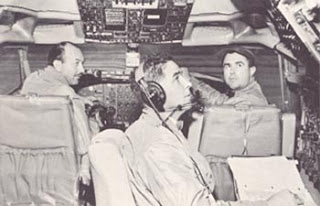Alvin M. "Tex" Johnston 1914-1998

 Tex Johnston (Right) with Guy Townsend
Tex Johnston (Right) with Guy Townsend Barrel Roll of the Dash-80
Barrel Roll of the Dash-80 Crew of the Boeing Dash-80 Maiden flight, Pilot Tex Johnston, Co-Pilot Jim Gannett and the Flight Engineer Tom Layne.
Crew of the Boeing Dash-80 Maiden flight, Pilot Tex Johnston, Co-Pilot Jim Gannett and the Flight Engineer Tom Layne. Flown cover on Boeing 707 Record Flight between Seattle and Baltimore,signed by Tex Johnston. By the time Johnston broke the transcontinental speed record in 1957 by flying from Seattle to Baltimore in three hours, 48 minutes, orders for the new 707 were pouring in.
Flown cover on Boeing 707 Record Flight between Seattle and Baltimore,signed by Tex Johnston. By the time Johnston broke the transcontinental speed record in 1957 by flying from Seattle to Baltimore in three hours, 48 minutes, orders for the new 707 were pouring in.Tex Johnston (1914–98) was one of America’s significant aviation pioneers, and he deservedly became a member of the National Aviation Hall of Fame. He grew up a classic all-American boy and experienced a pretty good rags-to-riches life, which included a paper route and saving to buy his first glider and his first motorcycle. But his passion was flying—that’s where he ended up no matter how many detours he took or how high he rose. His first exposure to an airplane came as a kid of 11 when a barnstorming pilot offered a free ride to the locals, and he was the only one to take the offer. From that point he was committed, and he devoted his free time to the study of airplanes. Still, his route from Kansas to the hall of fame was circuitous and unusual in that it did not include military flying. His journey included training and employment as a mechanic, catch-as-catch-can flight instruction, and—finally—civilian flight school. He moved from barnstorming to the Apollo program without making a fatal mistake in an accident-prone profession. With a little bit of luck and a lot of skill (knowledge, training, and practice), this Kansas boy who wanted to be a test pilot eventually made it without fighting in either World War II or Korea. Over his career, he flew or tested just about every significant aircraft, from biplanes to the supersonic XP-59—the first American-made jet. As he rose through the ranks at Bell and Boeing, he played a key role in making planes faster and safer. Even when his job title put him behind a desk, he kept flying until his projects went into space.
Tex Johnston was one of the pioneers of military and commercial aviation. He made helicopters functional for oil exploration and made the Boeing 7–series planes safe and successful for passenger flight.



<< Home